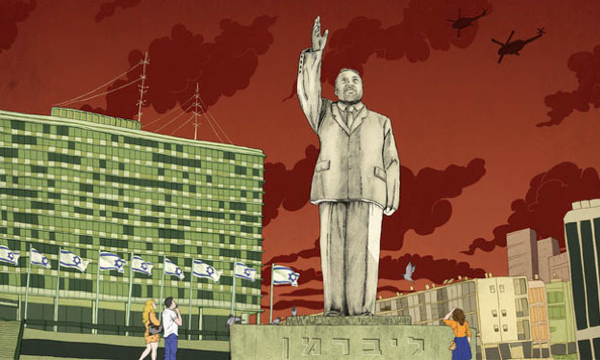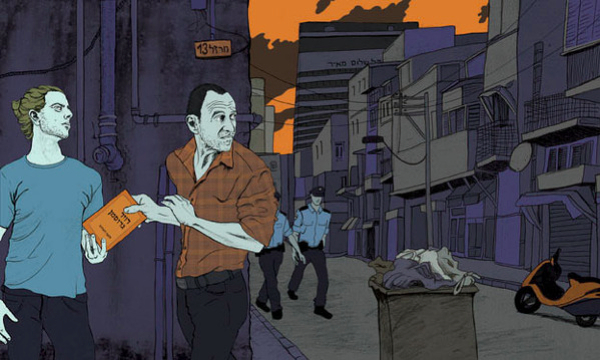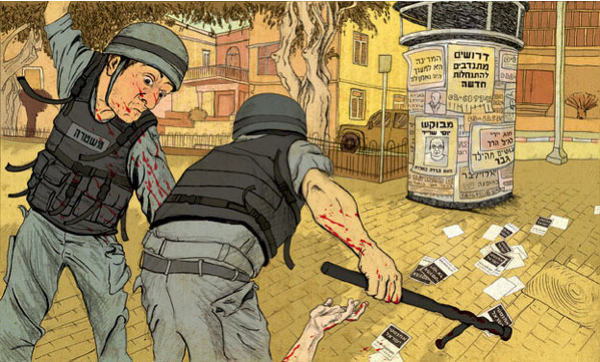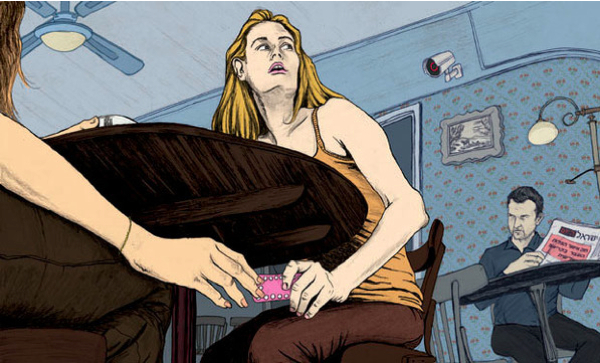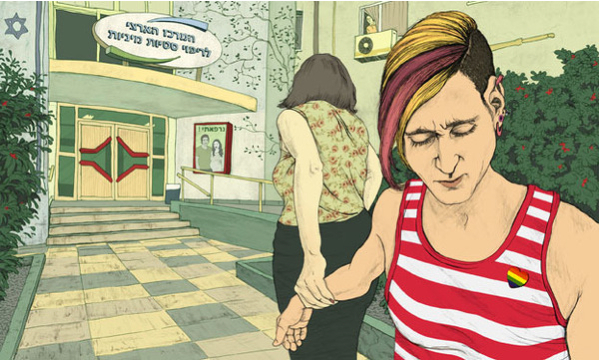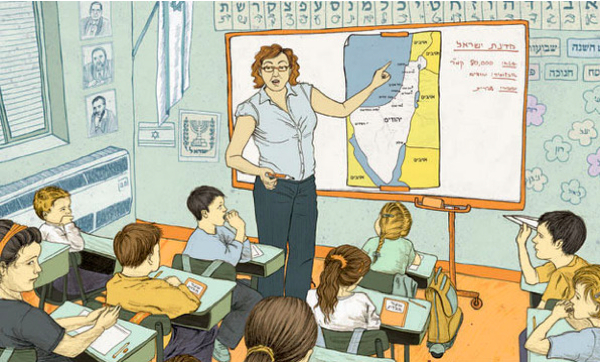For her senior project in visual communications at the Holon Institute of Technology (HIT), artist Sivan Hurvitz exhibited a series of illustrations called “Turn right at the end: the future of a country that gave up on democracy.”
In her strikingly realistic, detailed illustrations – six in all – Sivan imagines “an apocalyptic, harshly exaggerated, imaginary, future scenario” in an Israel that is no longer a democracy. Her purpose, she writes, is “to provoke and raise questions among Israelis about the direction the country is going in and to think if this is the country we want to become in the future.” She notes that, while the scenarios are purposely exaggerated, each illustration was inspired by a real-life event that is described in the caption. I have added explanatory notes under the description of the event that inspired each photo.
Inspiration: In April 2009 the Yisrael Beiteinu (Israel Our Home) party presented a legislative bill that came to be called the Loyalty Law. According to the bill, the granting of Israeli citizenship would be predicated on the applicant’s agreeing and signing a declaration of “loyalty to the state of Israel as a Jewish, Zionist and democratic state, to its symbols and values respectively.” The bill obligates every citizen to serve in the Israeli military or in the ranks of alternative organizations, and authorizes the Minister of Internal Affairs to revoke the citizenship of whoever refuses to sign or to serve the country according to the aforementioned declaration.
Notes (LG): The totalitarian-realist style statue shows Avigdor Liberman, head of Yisrael Beiteinu and current Foreign Minister. The statue is placed in Rabin Square, the place where Yitzhak Rabin was assassinated in 1995. The building in the background is the Tel Aviv Municipality, which was designed in the 1970s Brutalist style of architecture.
Inspiration: On May 2010 Professor Noam Chomsky, a renowned linguist and critic of Israeli policy in the occupied territories, was denied entry into the occupied territories. The Ministry of Internal Affairs confirmed that the decision was theirs and within the bounds of the ministry’s jurisdiction. In an interview following the incident, Chomsky mentioned that he was told that the government does not approve of his opinions and of the fact that he chose to visit Bir Zeit University instead of an Israeli university.
Notes (LG): The name of the author on the book is David Grossman, one of Israel’s most renowned authors and a vocal peacenik who frequently speaks out against government policies. The typically Tel Aviv-style street is named Marzel, for extremist settler movement leader Baruch Marzel, a disciple of the late Meir Kahane. The tall building in the background is Tel Aviv’s Shalom (Peace) Tower, once the tallest building in Israel.
Inspiration: Following the publication of the Goldstone Report, which accuses both Israel and Hamas of war crimes, the right-wing Im Tirtzu movement launched a media campaign that accused human rights organizations of collaborating with the enemy. The movement published a report claiming that most of the testimonies in the Goldstone’s report originated with various Israeli human rights organizations. What followed in May 2010 was a legislative bill that proposed the de-legitimization of all Israeli organizations and associations providing information to foreign authorities in order to bring military officers and politicians suspected of committing war crimes to justice.
Notes (LG): The scene is set on a recognizable corner of Rothschild Boulevard, in front of a building called the Levin House, which was the Soviet embassy in the 1950s. The paramilitary police beating the man with the leaflets are called Yasam; they are frequently deployed to break up political demonstrations in East Jerusalem and the occupied West Bank, and have come under criticism for employing excessively violent tactics. The notices on the pillar include one that is a “Wanted” sign for Yossi Sarid, a former left-wing political leader who is now a columnist for Haaretz. Other notices are for a workshop in shooting, a call for volunteers to join a new settlement and a reminder: “the state is for you; be loyal to it.” The fliers scattered on the pavement are from Amnesty Israel.
Inspiration: In 2002 the mandate for the National Council of Demographics was renewed, with a stated goal of providing recommendations to assure the preservation of a Jewish majority in Israel – largely by encouraging women to have more children. Shlomo Benizri (Shas), then Minister of Social Affairs, declared that “the fear of losing Israel’s unique character obligates us to take action so as not to become a minority in our own country within a decade or two.”
Notes (LG): The man in the background, sitting under the closed circuit camera, is reading the right-wing, pro-Netanyahu newspaper Yisrael Hayom (Israel Today). The headline is, “Anti-abortion law passed its third reading [in the Knesset].”
Inspiration: In May 2010 a member of Be’er Sheva’s city council, Zachariya Ohev Shalom, attacked the municipal decision to sponsor a pride parade in the city of Be’er Sheva. He stated:”I don’t hate the gay-lesbian community in Be’er Sheva, they are simply sick and in need of treatment.”
Notes (LG): The building looks like a typical Israeli national health clinic, but it is called the National Institute for the Treatment of Sexual Deviations.” The slogan over the poster on the right, showing the heterosexual couple, is “I’m cured!”
Inspiration: In July 2010 the Ministerial Committee on Legislative Issues approved the Nakba Bill, which in its initial stages called for the imprisonment of anyone who commemorates the Israeli Independence day as a day of mourning. In its current form the bill calls for denial of public funding to any organization that publicly commemorates the Palestinian narrative of the events of 1948 (Nakba means catastrophe). Several days later the Ministry of Education decided to eliminate the term “Nakba” from the Arab sector’s school curriculum.
Notes: The classroom looks like a typical elementary school classroom anywhere in Israel, which makes the deviations so striking. The teacher is pointing to a map that shows Greater Israel – the vision advocated by the Revisionist party (precursor to the Likud). The white swathe of territory, which includes the Egyptian Sinai, the West Bank and Gaza, is labeled in large, bold font: JEWS.
On the whiteboard, to the right of the map, is the following information:
STATE OF ISRAEL
Area: 80,000 kilometers
Population: Jews
Language: Hebrew (Arabic is currently Israel’s second official language).
The textbooks on the pupils’ desks are titled “Homeland Studies.”
On the left wall, near the flag, where official portraits of the prime minister and the president might be hung, are three portraits of extreme right-wing politicians: Rehavam Zeevi of the now-defunct Moledet party, which advocated transferring the Palestinians out of the West Bank and Israel; Avigdor Liberman, leader of the ultra-nationalist Yisrael Beiteinu party; and Rabbi Meir Kahane, founder of the now-banned Kach party, which advocated both transfer of the Palestinians and replacement of civil law with Jewish theological law (Halacha).
Sivan Hurvitz’s illustrations now appear on the Democracy Project website. The Democracy Project was initiated under the auspices of ACRI, the Association for Civil Rights in Israel. The site, which is now online in Hebrew and Arabic, will debut next week in English.
Click here to view: An artist visualizes Israel as a non-democratic state (II)


